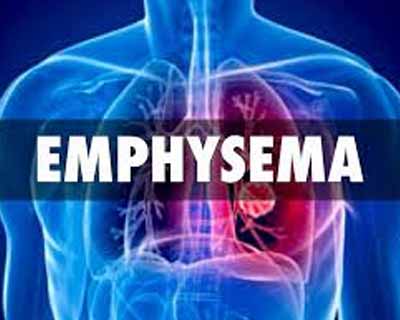- Home
- Editorial
- News
- Practice Guidelines
- Anesthesiology Guidelines
- Cancer Guidelines
- Cardiac Sciences Guidelines
- Critical Care Guidelines
- Dentistry Guidelines
- Dermatology Guidelines
- Diabetes and Endo Guidelines
- Diagnostics Guidelines
- ENT Guidelines
- Featured Practice Guidelines
- Gastroenterology Guidelines
- Geriatrics Guidelines
- Medicine Guidelines
- Nephrology Guidelines
- Neurosciences Guidelines
- Obs and Gynae Guidelines
- Ophthalmology Guidelines
- Orthopaedics Guidelines
- Paediatrics Guidelines
- Psychiatry Guidelines
- Pulmonology Guidelines
- Radiology Guidelines
- Surgery Guidelines
- Urology Guidelines
Tiny coil implantation in the lungs help severe Emphysema patients

Pittsburgh : The minimally invasive implantation of tiny coils into the lungs improves exercise ability, lung function and quality of life for patients with severe emphysema, according to a large international trial presented by researchers at the University of Pittsburgh School of Medicine. The findings were published in the Journal of the American Medical Association and presented at the American Thoracic Society International Meeting in San Francisco.
"Some patients with advanced emphysema have few treatment options, and this trial significantly furthers our understanding of the potential role of minimally invasive lung volume reduction therapy as an option to improve symptoms," said lead author Frank Sciurba, M.D., director of the UPMC Pulmonary Function and Exercise Physiology Laboratory, and professor, Division of Pulmonology, Allergy and Critical Care Medicine at Pitt.
Patients with emphysema, a form of chronic obstructive pulmonary disease (COPD), experience an over-inflation of the lungs that limits their ability to breathe deeply, resulting from progressive destruction of the air sacs of their lungs and collapse of the airways. The coils are intended to improve the elastic properties of the lungs to prevent collapse of the airways, allowing patients to exhale more completely, Dr. Sciurba explained.
The study included 315 patients recruited at 26 sites in the U.S. and Europe between December 2012 and November 2015. With over 75 percent of study participants experiencing severe symptoms yet having a pattern of emphysema not allowing them to be candidates for surgery or experimental valve treatment, those patients had few therapeutic options short of lung transplantation.
Participants were randomly assigned to either standard care, which included optimal inhaler medications and pulmonary rehabilitation, or to receive standard care plus bilateral coil insertion placed in the most severely affected lobe of each lung.
The researchers measured how far participants could walk in six minutes, both at baseline and after 12 months of treatment. Patients who received coils showed a modest improvement in walking distance at 12 months, while the usual care group declined in function over the same time period.
After one-year follow-up, the coil group overall was able to walk 15 meters farther than the usual care group in the allotted six minutes. Forty percent of the coil group was able to walk an additional 25 meters more, while only 27 percent of the non-coil group achieved those walking gains.
Forced expiration of air, the most common measure of lung function in emphysema patients, also improved in those receiving coils more so than in those who didn't receive them.
Patients receiving coils reported dramatic improvement in their quality of life, which is measured by the emphysema specific St. George's Respiratory Questionnaire, with 32 percent more patients in the coil group achieving a meaningful level of self-reported improvement over those in the non-coil group.
The benefits of the coils did come at a cost initially, patients had a significantly higher rate of major complications such as pneumonia and pneumothorax than those in usual treatment group. However, the increased risk of serious adverse events appeared to be short lived. By nine months, there was no difference between the two groups. There also was no difference in the death rate measured at 12 months.
The investigators learned over the course of the study that some of the events initially thought to be pneumonia may in fact be changes in the X-ray due to tension from the coils that may in the long run result in a better patient improvement.
Additional findings by the investigators identified patients who may achieve the greatest benefit from coils. Patients with the greatest degree of lung over-inflation had the greatest improvements in walk distance and symptoms compared to the least over-inflated patients. Also, patients with additional medical issues beyond COPD appeared to improve less.
"Overall, the coils provided a modest improvement in exercise ability and lung function, and a very clinically important improvement in quality of life, but with a higher likelihood of major complications," Dr. Sciurba said. "This provides an evidence-based choice for symptomatic patients with few options."
The U.S. Food and Drug Administration (FDA) will now determine whether the coils are ready for widespread use, he added.
UPMC's Division of Pulmonology, Allergy and Critical Care Medicine has a long history of pioneering treatments for lung disease, beginning with innovations in lung volume reduction surgery in the mid-1990s and continuing with active involvement in clinical trials aimed at providing a less invasive treatment approach. UPMC also is home to a leading lung transplant program.
"This trial represents an extension of a 20-year legacy of UPMC leadership in surgical and bronchoscopic lung volume reduction approaches," said division chief Rama Mallampalli, M.D.
The trial was sponsored and funded by PneumRx Inc., and representatives of the FDA assisted in the design of the trial.

Disclaimer: This site is primarily intended for healthcare professionals. Any content/information on this website does not replace the advice of medical and/or health professionals and should not be construed as medical/diagnostic advice/endorsement or prescription. Use of this site is subject to our terms of use, privacy policy, advertisement policy. © 2020 Minerva Medical Treatment Pvt Ltd